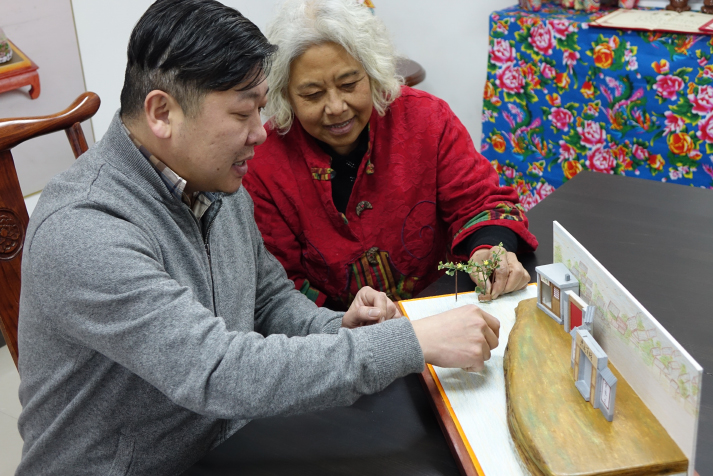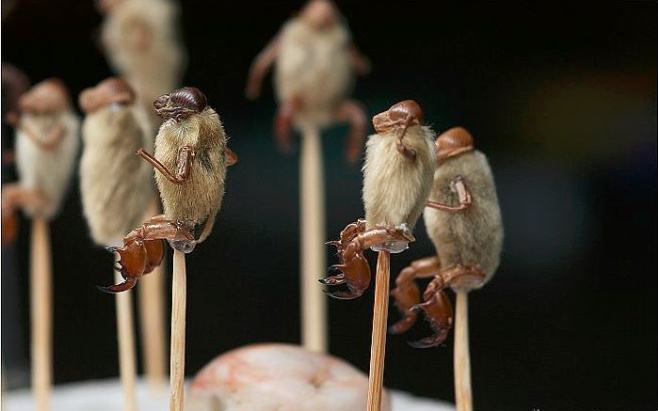| Lifestyle |
| Modernizing a Traditional Craft | |
| A mother-and-son team inherits a native art of Beijing | |
|
|
 Song Lei and his mother discuss hairy monkey-making techniques (COURTESY PHOTO)
I was born into a working-class family in Beijing in 1979, the year after China decided to reform and open up. As a child, I loved the arts thanks to the influence of my mother, an aficionado of traditional arts and crafts.
My mother has always been passionate about life. She grew up in the Liulichang area in downtown Beijing where for centuries many high-end painting and calligraphy studios and stores for various folk arts have been congregated. Like most families in the early 1980s, my family was strapped for cash. However, that didn't stop my mother from gussying up our shabby home with whatever materials were available. In the autumn, she would put a twig with persimmons attached on our table by the window, and place a few golden fallen leaves around it. As the morning sunshine peeped in, it became a picturesque scene that warmed and lightened up our home. She recycled our old clothes and bed sheets, and even made collages from cloth scraps. For all these ingenious creations, mother simply said, "I saw it in my childhood." I had no idea what life was like when she was a girl, but it must have been different from mine.  Hairy monkey figurines(COURTESY PHOTO)
A retiree-turned-artist In the late 1990s, my mother's employer was struggling financially and allowed her to retire earlier than planned. With more free time, she took to making various handicrafts, such as the Chinese Knot, flour sculptures and fabric collages. On one occasion, my mother met an elderly master of hairy monkey figurines, who complained about the generational rupture in the heritage of traditional culture. He expressed his concern of having no one to carry on his trade, since it was facing a narrow market, not bringing in a livable income and struggling to appeal to young people. Because the artwork was reminiscent of her early years, my mother decided to learn how to make the hairy monkeys. A native art of Beijing, the hairy monkey is a miniature figurine made of cicada slough (for the head and limbs) and magnolia bud (for the torso). It is named so because the figurines look like hairy monkeys. It is accompanied by props that reconstruct a scene about life in old Beijing. My mother felt cut off from society in her retirement and was eager to find a way to express herself and communicate with the world. Because of her experience with other handicrafts, she made swift progress and soon became a master in the field. She was later recognized by the Beijing Municipal Government as an official inheritor of the hairy monkey art. Following the State Council's notice on enhancing protection of cultural heritage in 2006, the government has steadily given support to antiquated arts and crafts, while market demands for them have been growing. In the past, many old arts and crafts faded out of public view because they were void of practical functions and weren't able to find buyers as most people in the country were only scraping by. There were some people who partook in these cultural activities, but mainly as hobbies instead of vocations. After an increase in affluence, people in China now have the money to satisfy their long-suppressed cultural needs, unleashing market demands for these arts and crafts. My mother grew busy. She was invited to cultural events organized by our neighborhood and to international exchange activities. Many primary schools in Beijing incorporated traditional culture into their curricula, and my mother began giving a hairy monkey class once a week at a local school. Her class always fills up quickly after registration opens. She also teaches in public libraries, cultural centers and folk art museums, adding up to teaching a class every day. Rebuilt links I grew up in the age of reform and opening up, when Western culture and pop music entered China and exerted tremendous influences on its youth. By contrast, the presence and influence of traditional culture were diminishing. Bric-a-bracs my mother's generation played with in their childhood, such as rabbit figurines, flour sculptures and malt candy art, were rarely seen when I was a boy. Thanks to my mother, I fell in love with painting at a young age. After finishing middle school in 1994, I entered an art and design school, and after graduation went on to study at a light industry college in Dalian, a coastal city in northeast China's Liaoning Province. Two years later, I felt a strong desire to learn the advanced culture and knowledge in a developed country. It was the year 2000, when new media had emerged as a pillar industry in developed economies, and thus, I decided to go study new media design in Germany. I spent the following nine years there and obtained my master's degree. I returned to Beijing at the end of 2009. The city was very different from the one I left. I needed some time to readjust and figure out how to apply what I had learned abroad locally. I first found a job with an advertising company and then moved to an IT company as a user interface designer one year later and stayed there for three years. Having learnt all the classics and works by luminaries in their respective fields in Germany, I was unimpressed by folk art. My mother's hairy monkey pursuit was no more than a pastime to me. However, this attitude slowly changed. In 2013, my mother's hairy monkey mentor could not give classes any more due to health reasons and needed someone to pick up the slack at the two schools where he taught. The time didn't fit my mother's schedule, so she recommended me. Thus, I became a freelancer giving courses on traditional arts and crafts to children. More than a decade after my 8,000-km trip to Germany, I was back at the starting point. Life has been and will continue to be unpredictable. Aligning old and new I studied art and design in school, but all arts are interrelated. My academic background helped me learn how to make the hairy monkey, which involves multiple skills. In the learning process, I discovered a sense of fun, shared by my mother, and came to appreciate the charm of folk arts and crafts as well as the culture behind them. In the past few years, an increasing number of primary and middle schools in China have begun to offer courses on intangible cultural heritage. Besides my teaching activities, I founded a research team with my art school friends. We designed courseware and experimented with new ideas on teaching. I also introduced new technologies into my hairy monkey class. For instance, I developed a demonstration using 3ds Max to display the production process of the hairy monkey on a big screen. What's more, I encourage my students to place hairy monkey figurines in settings plucked from their lives, such as calling 119 and 110 when encountering a fire or a crime. This way, the age-old handicraft becomes educational and relevant to current times, responding to issues of concern among teachers and parents. My team is teaching in several primary and middle schools and I feel very proud. For a long period in the past, craftspeople could not make a decent living, and therefore very few from the younger generation would enter these trades. Things are different now. With strong government support and solid market demands, I can support myself sufficiently by practicing a craft that I love and that introduces me to many like-minded people. It has provided me with the life I've always dreamed of living. It takes passion and innovation to revive a traditional culture. My hairy monkey works are different from those of my mother as they focus more on the present, what's happening in it, and what appeals to young people. My mother's works are about the past and how she remembers old Beijing. My team and I plan to develop derivative products involving technologies that are more advanced. Though the work is still in the early stages, every new attempt and every breakthrough is heartening and sustains our resolve to press forward on this course. The article was first published in China Today Copyedited by Rebeca Toledo Comments to yanwei@bjreview.com |
|
||||||||||||||||||||||||||||
|